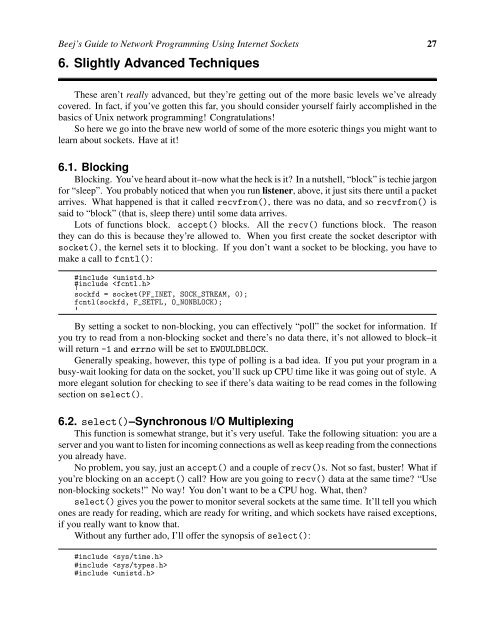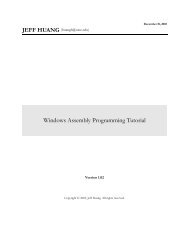Beej's Guide to Network Programming Using Internet Sockets
Beej's Guide to Network Programming Using Internet Sockets
Beej's Guide to Network Programming Using Internet Sockets
- No tags were found...
Create successful ePaper yourself
Turn your PDF publications into a flip-book with our unique Google optimized e-Paper software.
Beej’s <strong>Guide</strong> <strong>to</strong> <strong>Network</strong> <strong>Programming</strong> <strong>Using</strong> <strong>Internet</strong> <strong>Sockets</strong> 276. Slightly Advanced TechniquesThese aren’t really advanced, but they’re getting out of the more basic levels we’ve alreadycovered. In fact, if you’ve gotten this far, you should consider yourself fairly accomplished in thebasics of Unix network programming! Congratulations!So here we go in<strong>to</strong> the brave new world of some of the more esoteric things you might want <strong>to</strong>learn about sockets. Have at it!6.1. BlockingBlocking. You’ve heard about it–now what the heck is it? In a nutshell, “block” is techie jargonfor “sleep”. You probably noticed that when you run listener, above, it just sits there until a packetarrives. What happened is that it called recvfrom(), there was no data, and so recvfrom() issaid <strong>to</strong> “block” (that is, sleep there) until some data arrives.Lots of functions block. accept() blocks. All the recv() functions block. The reasonthey can do this is because they’re allowed <strong>to</strong>. When you first create the socket descrip<strong>to</strong>r withsocket(), the kernel sets it <strong>to</strong> blocking. If you don’t want a socket <strong>to</strong> be blocking, you have <strong>to</strong>make a call <strong>to</strong> fcntl():#include #include.sockfd = socket(PF_INET, SOCK_STREAM, 0);fcntl(sockfd, F_SETFL, O_NONBLOCK);.By setting a socket <strong>to</strong> non-blocking, you can effectively “poll” the socket for information. Ifyou try <strong>to</strong> read from a non-blocking socket and there’s no data there, it’s not allowed <strong>to</strong> block–itwill return -1 and errno will be set <strong>to</strong> EWOULDBLOCK.Generally speaking, however, this type of polling is a bad idea. If you put your program in abusy-wait looking for data on the socket, you’ll suck up CPU time like it was going out of style. Amore elegant solution for checking <strong>to</strong> see if there’s data waiting <strong>to</strong> be read comes in the followingsection on select().6.2. select()–Synchronous I/O MultiplexingThis function is somewhat strange, but it’s very useful. Take the following situation: you are aserver and you want <strong>to</strong> listen for incoming connections as well as keep reading from the connectionsyou already have.No problem, you say, just an accept() and a couple of recv()s. Not so fast, buster! What ifyou’re blocking on an accept() call? How are you going <strong>to</strong> recv() data at the same time? “Usenon-blocking sockets!” No way! You don’t want <strong>to</strong> be a CPU hog. What, then?select() gives you the power <strong>to</strong> moni<strong>to</strong>r several sockets at the same time. It’ll tell you whichones are ready for reading, which are ready for writing, and which sockets have raised exceptions,if you really want <strong>to</strong> know that.Without any further ado, I’ll offer the synopsis of select():#include #include #include












